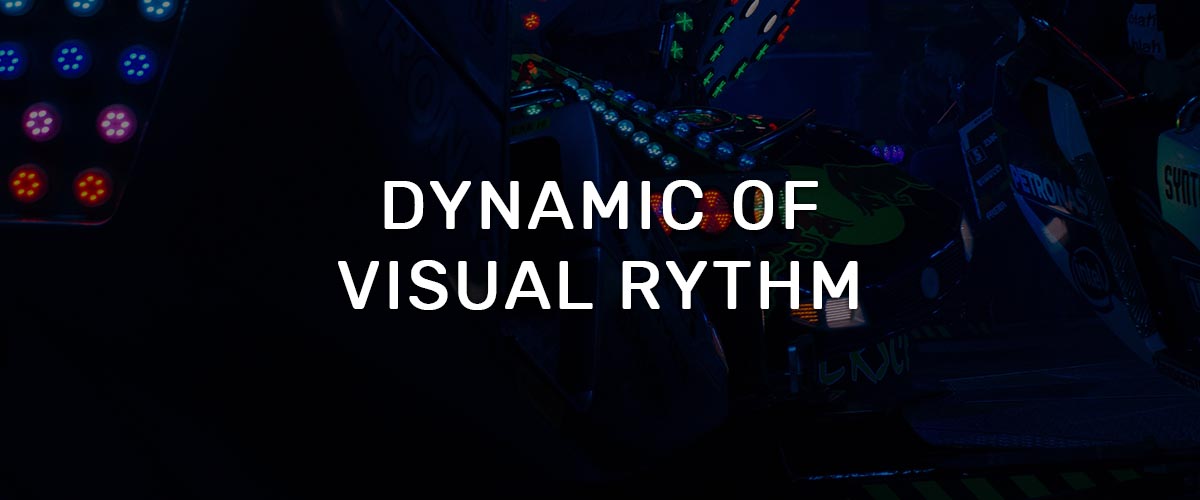13 Nov WHAT IS THE Dynamic of Visual RythM

In this article I’ll focus on what is visual rythm and how it can be satisfying for the eyes. Like a tiny essay, we will explore differents characteristics around video and motion.
There is 5 key factors in visual rythm :
1/ Motion in Shot
2/ Camera Movement
3/ Length of Clip
4/ Framing Diversity
5/ Color and Luminance Contrast

This is what most people think about when it comes to the word movement. A character running, a car race, titles fading out… Pixels moving around the screen is a juicy tool to abuse. You can have a single-shot-sequence of 10minutes and feel an amazing rythm because of what is happening on screen provides you a high sense of entertainment. This is what has been done for years in the early years of filmmaking.
For example, a combat scene act like a coregraphy, it is often treated as a dance because there is beauty in the consecutive movement of an action. Music is often put in parallel to video because of the very intimate relationship they have and commonalities they use.
The movement of an object/character can have meaning, the most known example is the motion from left to right (to the future) or from the right to the left (to the past). In the contrary, static objects and character describe stoïc, trauma, freeze time or. The juxtaposition of different types of movement can create a whole, with meaning and story. The variety of direction and speed allows for infinite possibilities.

The opportunity to move a camera is an amazing tool to support your story. One interesting choice is to keep your camera still.
Static shot (or extremely slow) can be used to establish your environnement and focus on showing an important asset, like a castle, an object or a character.
You can go from slow to fast over time, stressing out the viewer by increasing the velocity of the camera along the trailer length. Choosing to turn it, destabilize the spectator conciously to get to a very precise moment that will have a more powerful impact overall, because you have had setup previous movement intentionnally.
A lot of action-packed production and games associate this technique with fast editing, the heartbeat rate of the viewer rise and gives him a sense of action.

The editing is a tricky process. The possibilities are infinite and the length of each clip rest on many variables.
One particularly important mistake is to treat the edit on the tempo of the music. Cutting on the beat without intention makes your edit boring and expected. When you are bored, time feels slow.
Important cues of the music can be used, but if you use every single beat of the music as a cut reference, you ends up with clips of the exact same duration. This is why a lot of editor cut without music at first, this allow you to create an edit that doesn’t have edit mistakes hidden by the music. The edit and length of each clips should be treat as a music by itself. Elísabet Ronaldsdóttir, the editor of Atomic Blonde/John Wick teach us that her combat scenes are cut in a way that any music can be used over the scene. The music supports the edit, not the other way around.
There is a movement to the way a scene is cut with clips of 24images, then 59, then 33. When done correctly, the editing flows and the length of each clip is unique and is perfected to fit in the complete work. Obviously the length depends on many variables and there is no magical formula (action, rythm, recognizing what is happening…)

The composition of a shot is not a movement, but put side by side with other shot you’ve got contrast. It is like having differents cues of music (closeup would be the guitar, large shot the drums…). There is a certain rythm to having a diversity of framing and composition, allowing you to gauge the interest of all your shots.
Like stories and their ability to rise to a climax, a well-thought framing allow you to put a special note on a shot. Not all composition are equal and what you show and don’t show on your image is equally important.
Framing can be tricky when it comes to gameplay sequences. Takes FPS for example, the field of view is locked and we only use the subjective point of view.
Composition by itself is what we have took from photography. By essence, there is movement in any shape. When you look at the image of a spiral, nothing is moving but your brain associate it with an inner (or outer) movement. This mean we can use a sub-form of movement using our experience with art in general since our birth.

Color and Luminance are amazing storytelling tools that can be used to convey emotions and provide meaning. We are all used to colors and their effect on our perspective, how dark and light can change our opinion on the exact same thing.
For most people, Heaven is light and Hell is darkness, red is passion and danger, blue is peace and calm. A simple example would be a trailer starting with a very bright and colorful style, and slowing reaching to a dark and desatured mood. Turning slowly into the dark, we might be watching at the downfall of the main character. Maybe it is about Heaven turning to Hell and how we are going to fight back. There is a movement to the way colours change and a meaning to its choice.

There is a musical perspective to take in consideration. Harmony is achievable with notes, rythm and purpose. The progression of it, like stories, provides meaning that directly connect with our most primitives instincts.


